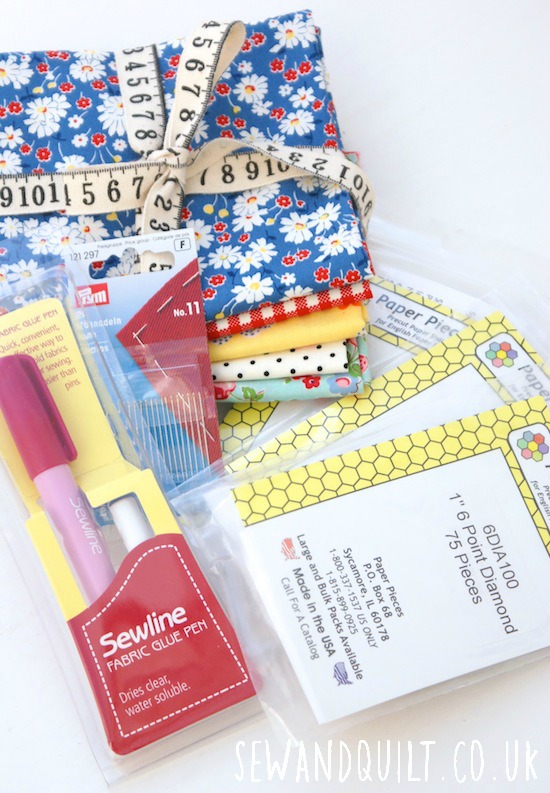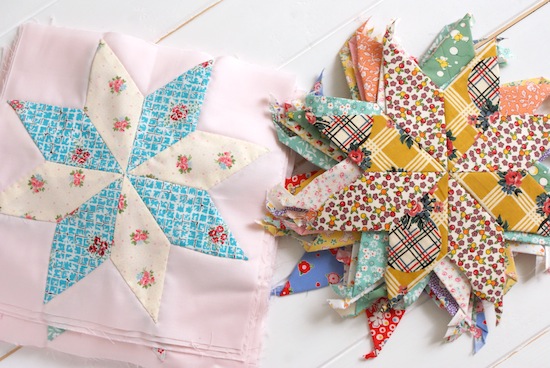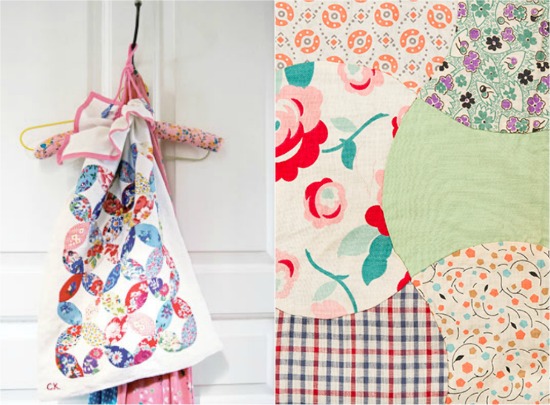Welcome back to part two of our hexagon special on our English Paper Piecing series! We will be joining our shapes together today to form our hexagon flower. Just a reminder that all the images can be enlarged further by clicking on them.
![]()
How To Make A Hexagon Flower?
1. Place two pieces right sides together. I'm starting with my 'flower centre' and working on my first 'round' using a solid colour.
2. Start with a knot at one end of your thread, use a co-ordinating thread colour to match your fabrics.
3. Needle through the fabric with right sides together. 4. Pull tight and move up the hexagon side continuing this whipstitch. You'll want to aim for about 14-16 stitches per inch, I think that's about every 2mm? You'll start to recognise a 'safe' distance once you do it repeatedly.
I've been asked a lot on the the first post, "how do I keep my stitches neat and invisible?".
Answer: Try to catch only a couple of threads of fabric in each stitch, you don't need your needle to be 'eating' deep into the side of the hexagon - this is how they become visible. Likewise don't catch less than one thread of fabric, your work will eventually pull and become loose - trust me, I've been there.
Also try to keep an even tension on your stitches, using the same distance each time; as with knitting I guess (not that I have any idea on that subject!). You will get more of a rhythm, and it will look neater from the front.
Lastly. Practice! Lot's of practise, practise, practise! I can't tell you how much I have improved by doing it repeatedly.
5. The corners! Make sure you get right to the tip of the corner - notice how in the picture above I'm not catching the folds at all in my last stitch. This helps keep it neat.
Now onto the next hexagon, with an inset seam! These are easily achieved with EPP as you can bend and manipulate the papers to sew accurately.
6. Starting on the outside edge; whipstitch as before until you reach the corner. Sew 2 or 3 stitches at the corner (where you are meeting the next hexagon) for a nice tight seam. Remember to only catch a couple of threads of fabric, not too much - so it won't be visible form the front.
"Oh, but there's a gap between my hexies!?".
Not a problem. It's paper remember - just turn them together together and wrangle them so they meet; paying close attention that the tips meet perfectly.
![]() 7. Right let's carry on whip-stitching up the other side.
7. Right let's carry on whip-stitching up the other side.
Remember to keep that nice even tension pulling the thread taught with each stitch. I've noticed in my previous EPP projects I've not pulled it tight enough and the shapes are slightly loose - which makes the stitching visible. Learn from my error!
It isn't very easy to demonstrate in photo's but to help keep my stitches even I like to run the needle along the side of index finger, which I find helps me keep balance, and stops me 'eating' into the fabric too deep. So imagine in this photo - my thumb out the way a bit, my index finger extended more and the needle on top of it...
Notice how I catch all three sides when I get to the inset seam - but not the fold of the hexagon, just the very corner. It helps pull everything tight and neat, ready for the next side.
Now continue with the next round using the same technique.
Voila! One completed block. You can add in more rounds, then add in a neutral or contrasting 'garden path' in one or two rounds. Change it up as you wish!
"But what about ladder stitch?", I hear you ask. I haven't tried it myself as it seems a longer way of doing it, and I'm pretty happy with how stitches look from the front to not try a new method. If you're interested in trying it out I've found a tutorial online here.
Liberty Tana Lawns & Voiles
We all love those Liberty fabrics and voile cottons don't we? I know lots of people like using them in their EPP work too - including me! However, a word of caution because of their very sheer and lightweight nature, the fibre's of the thread could eventually tear the fabric because of the excessive drag when the papers are removed. I've included this method below of reinforcing your hexagon sides to make a very strong seam. Try it!
1. Start your hand sewn basting as you would normally. Knot your thread, needle in one edge, and backstitch.
2. Instead of whipstitching as you usually would - insert the needle in the next corner of the hexagon side, and backstitch to secure.
3. Now whipstitch down the side of the hexagon towards the first corner. Notice you are catching that long 'reinforcing stitch' inside each whipstitch. Under and over, under and over...
Really strong! and you can't even see it ;-)
Contrasting Fabric and Thread Choices
So what if you are choosing two completely different fabric colours, what thread do you use? From what I've read it's been told to take the darker thread of the two. However, I've found I get better results from going lighter. I thought it would be best to show this in action! Here I have joined bright red and white fabric shapes together.
On the right I have used a matching red thread, on the left I have used an off-white thread. As you can see the off-white is practically invisible, whereas the red thread is visible slightly. So I would always go lighter when there is a contrast. If you have to contrasting bright fabrics - a grey thread is always a good go-to option if you're stuck.
I hope I've covered this section in detail so I've answered most of your questions on this and how to achieve a neat finish. Just drop a comment below if you wanted to know anything else, likewise feel free to share your tips for other readers. I love hearing new things! Next Monday we are doing diamonds!! My favourite! See you then, xo



























































